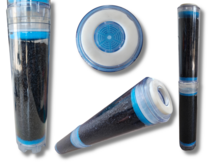Description
The 20" activated carbon filter element with a nominal filtration rating of 70 microns combines the adsorbent properties of activated carbon with the mechanical filtration of a filter element of this size. This type of filter is designed for use in standard 20-inch filter housings and provides an effective solution for removing not only sediment and suspended particles, but also a wide range of chemical contaminants, organic substances, chlorine, and taste and odor compounds from water. The specified pore size of 70 microns provides basic filtration of coarser particles, while the activated carbon matrix tackles the more subtle impurities.
Key features and benefits:
- Dual action: Sediment filtration and chemical adsorption: This filter element offers a combined approach to water purification. The 70-micron structure is effective in trapping sand, silt, rust, and other particles of similar or larger size. At the same time, the activated carbon adsorbs a wide range of dissolved substances, including chlorine (which can give water an unpleasant taste and odor), organic compounds (which can affect color, taste, and odor), pesticides, herbicides, and volatile organic compounds (VOCs).
- Improved taste and odor of water: One of the most notable benefits of an activated carbon filter is the significant improvement in the taste and odor of water. By removing chlorine and organic substances, the water becomes more pleasant to drink and use in food preparation.
- Removal of chlorine and chloramines: Activated carbon is highly effective in reducing free chlorine and chloramines, disinfectants that are often added to drinking water but can cause an undesirable taste and odor.
- Reduction of organic contaminants: The filter helps remove various natural and synthetic organic compounds that may be present in water as a result of pollution from agriculture, industry, or natural processes.
- Pre-filtration and protection of other systems: The 70-micron rating provides a degree of pre-filtration, removing larger particles before the water comes into contact with the activated carbon. This helps protect the activated carbon matrix from rapid clogging and extends the effective life of the filter element. It can also serve as an excellent pre-filter for finer filters or reverse osmosis systems, extending the life of these more expensive components.
- Standard 20-inch size: The 20-inch size ensures compatibility with a wide range of standard filter housings, making installation and replacement easy.
- Various types of activated carbon: Activated carbon filters can contain different types of activated carbon, such as granular activated carbon (GAC) or extruded activated carbon blocks. Each type has specific adsorption properties and may be more or less effective at removing certain types of contaminants. It is important to choose the right type of filter based on the specific water quality issues.
Aspects to consider:
- Lifespan and saturation: The adsorption capacity of activated carbon is not unlimited. Over time, the carbon becomes saturated and loses its ability to effectively remove chemicals. The service life of the filter element depends on the concentration of contaminants in the water and the flow rate. Regular replacement is crucial to ensure optimal performance. A noticeable return of chlorine taste or odor may be an indicator that the filter is saturated.
- Not all contaminants are removed: Although activated carbon is highly effective against many chemicals, it does not remove all types of contaminants, such as dissolved inorganic substances (e.g., heavy metals, fluoride) or microorganisms (bacteria, viruses). Other filtration methods may be required to remove these substances.
- Pressure loss: Activated carbon filters, especially those with a denser structure or a larger amount of activated carbon, can cause a slight reduction in water pressure. It is important to take this into account when dimensioning the filtration system.
- Maintenance and replacement: Activated carbon filters cannot be cleaned and must be replaced periodically to maintain their effectiveness. The recommended replacement interval varies depending on water quality and usage, but is often expressed in months.

